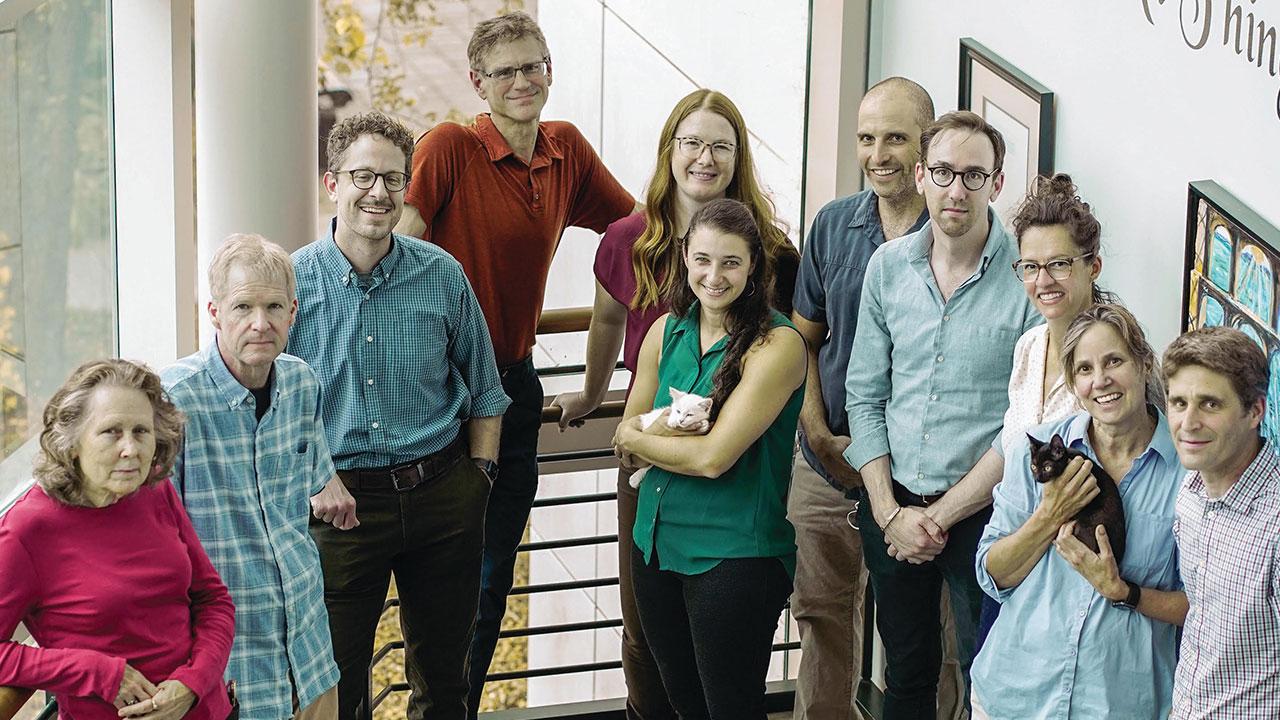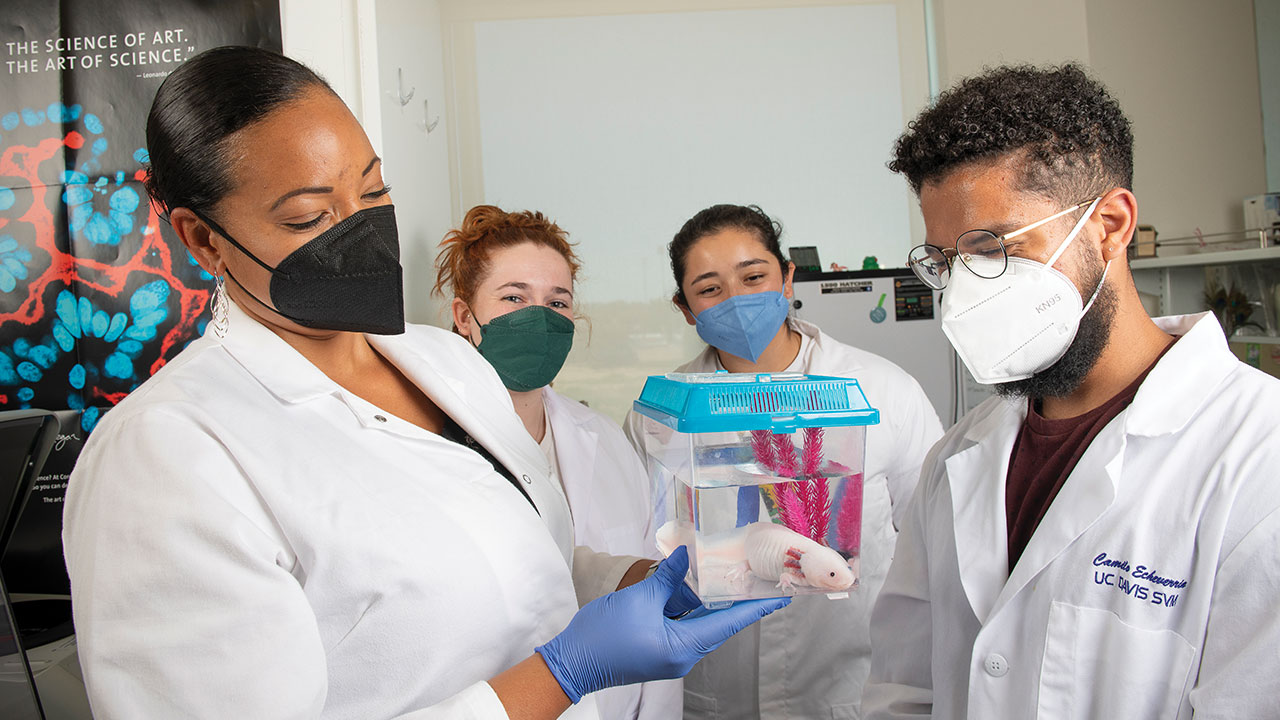
Photo: Vu Dao
Departments of Innovation
How does innovation flow from the school to improve health for animals, people and the environment? It starts with the six academic departments that each have a unique mission for driving veterinary medicine forward, and serve as centerpoints for collaboration. We’ve highlighted just one example of innovative research from each department along with their mission statements.

Department of
Anatomy, Physiology & Cell Biology
Crystal Rogers
Assistant Professor
Studying Neural Crest Cells to Understand Cancer and Congenital Anomalies
“Axolotls are amazing because they can regenerate almost every tissue in their body,” says Assistant Professor Crystal Rogers. She focuses on understanding how these unique aquatic salamanders develop at a molecular level by studying the formation of neural-crest cells. All vertebrate animals have neural-crest cells that develop similarly to those in axolotls, so Rogers’ research can potentially help us understand how animal and human cell development goes haywire—resulting in conditions from cleft palate to neuroblastoma—and possible ways to address cell development issues.
The Department of Anatomy, Physiology & Cell Biology’s mission is to emphasize programs with a strong correlation between structure and function, and to focus on integration of cellular and molecular biology—with the biology of cell populations organized as tissues, organs, organ systems and organisms.

Department of Pathology, Microbiology & Immunology
Patricia Pesavento
Professor
Working to Prevent and Cure FIP
“It is heartbreaking when feline coronavirus mutates into the often-fatal FIP virus, most commonly in young cats or kittens. We are tackling this decades-old problem by assembling teams that are developing antiviral therapy to cure the disease, and studies on potential prevention,” says Professor Patricia Pesavento, chair of the Pathology, Microbiology and Immunology department— a centerpoint for collaborators across the school. Pesavento leads the team of biophysicists, immunologists, and vaccinologists who are applying technologies used to study another coronavirus disease: COVID-19. The antiviral team, which includes board-certified veterinarians with special interests in infectious diseases, pathology, and virology, has launched two clinical trials described in the “Clinical Updates” section of this issue of Synergy. The combined approaches of prevention and cure give the researchers—and cat lovers—great hopes of saving felines from FIP once and for all.
The Department of Pathology, Microbiology and Immunology provides a unique and critical link between the basic and clinical sciences. The department integrates these disciplines to understand causes and diagnosis of disease in animals and the mechanisms by which diseases develop at the organismal, cellular and molecular, and, increasingly, genetic levels. The correlated applied (translational) mission is to advance the use of morphologic, microbiologic, biochemical, genetic, and immunologic methods for diagnosis and prevention of disease.

Department of Molecular Biosciences
Pamela Lein
Professor
Understanding the Effects of Environmental Chemicals
“We have the power to control exposure to environmental chemicals,” says Professor Pamela Lein, chair of the Molecular Biosciences department. “But we need to know which chemicals pose a health risk; and we need to develop compelling evidence to show our regulators and policymakers so they can go to bat to protect people.” Lein studies how environmental stressors, including chemical contaminants in the environment, influence the risk and severity of complex diseases, including neurodevelopmental disorders, asthma, Alzheimer’s disease and seizure disorders. She and her colleagues recently demonstrated a link between traffic-related air pollution and an increased risk for age-related dementia, including Alzheimer’s disease. Their findings corroborate previous epidemiological evidence showing the association.
The Department of Molecular Biosciences encompasses nutritional, physiological chemistry, and pharmacologic and toxicologic studies. Faculty study fundamental biological processes and their perturbations by mutations, nutrition, drugs and xenobiotics, and the application of these to the improvement of animal and human health.

Department of Medicine & Epidemiology
Munashe Chigerwe
Professor
Reducing Antimicrobial Use on Dairies
“In California, treatment of sick preweaned dairy calves is the major reason for antimicrobial (AMD) use on conventional dairies. This suggests that several management factors are contributing to this high proportion of morbidity requiring AMD use,” says Professor Munashe Chigerwe. He is studying the impact of several health and survival components for preweaned calves on conventional and organic dairies in the state such as: sufficient ingestion of high-quality colostrum (transfer of passive immunity), nutrition, the diagnosis and appropriate management of calfhood diseases, and reliable record keeping. The data from this study will be used to fill in knowledge gaps on preweaning calf management factors affecting antimicrobial use, form the basis for future studies on antibiotic resistance, and provide recommendations to improve antimicrobial use and stewardship.
The Department of Medicine and Epidemiology encompasses the diagnosis and treatment of disease, and maintenance of health for all species of animals. Epidemiology studies factors that determine and influence frequency and distribution of disease, injury and other health events in a defined population. It also establishes programs to prevent and control the development and spread of disease.

Department of Surgical & Radiological Sciences
Ronald H. L. Li
Associate Professor
Improving the Treatment of Wildfire-injured Cats
“Animals and humans are becoming more commonly exposed to wildfire smoke, particularly in California,” says Dr. Ronald Li, “so when we make gains in understanding how one species is affected, this knowledge can be beneficial across species.” Li recently led a study showing that cats impacted by urban wildfires have overactive platelets, the cells that help stop bleeding, making them prone to forming clots, which can lead to sudden death. The findings, which advance our understanding of overall cardiovascular health and disease, will not only impact early treatment plans for cats exposed to wildfires, but also further research in feline platelets and heart disease. The study also opens a new door to looking at how wildfires impact cardiovascular health in humans.
The Department of Surgical & Radiological Sciences facilitates research activities into diagnosis, pathogenesis, prevention, and treatment of animal diseases while providing education and leadership in veterinary clinical disciplines.

Department of Population Health & Reproduction
Rodrigo Gallardo
Professor
Sourcing Coronavirus Antibodies from Eggs
“Domestic poultry and humans are intertwined in many ways, including through aspects of our health,” says Professor Rodrigo Gallardo, “so it’s fitting that chickens could be a key to fighting human disease.” Gallardo is a poultry veterinarian and virologist who usually works on endemic diseases affecting commercial poultry such as infectious bronchitis coronavirus, avian reoviruses and infectious coryza. However, Gallardo recently published a study showing that antibodies specific for the COVID-19 virus spike protein can be produced from eggs by immunizing hens. He is working with colleagues at Stanford University and University of Technology, Sydney, to develop an egg-based antibody technology. The team hopes to deploy these antibodies in a preventive treatment such as a spray, that could be used by people at high risk of exposure to coronavirus.
The Department of Population Health & Reproduction is comprised of faculty with expertise in a variety of academic and clinical fields whose common focus is on the population as the unit of scientific interest.
